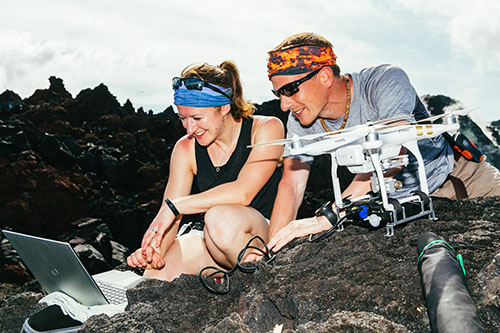The cutting-edge research at Manam volcano in Papua New Guinea is also improving scientists’ understanding of how volcanoes contribute to the global carbon cycle, key to sustaining life on Earth.
The ABOVE project was an international endeavour, bringing together leading experts from Bristol with others across the world, all with previous hands-on experience of using aerial robotics to study volcanic emissions.
The team included Bristol researchers Dr Kieran Wood, Dr Tom Richardson and Rob Clarke from the Flight Lab in Aerospace Engineering; Dr Matthew Watson from Earth Sciences and Professor Jim Freer from Geographical Sciences; as well as specialists from the USA, Canada, Italy, Sweden, Germany, Costa Rica, New Zealand and Papua New Guinea, led by Dr Emma Liu at UCL. Together they co-created solutions to the challenges of measuring gas emissions from active volcanoes, using modified long-range drones.
Volcanic emissions are a critical stage of the Earth’s carbon cycle - the movement of carbon between land, atmosphere, and ocean – but CO2 measurements have so far been limited to a relatively small number of the world’s estimated 500 degassing volcanoes. Measurements need to be collected very close to active vents and, at hazardous volcanoes like Manam, drones are the only way to obtain samples safely.
The team’s findings, published in Science Advances, show for the first time how it is possible to combine measurements from the air, earth, and space to learn more about the most inaccessible, highly active volcanoes on the planet.
By adding miniaturised gas sensors, spectrometers and direct sampling devices, the team was able to fly the drone 2km high and 6km away to reach Manam’s summit, where they captured gas samples to be analysed within hours.
Calculating the ratio between sulphur and carbon dioxide levels in a volcano’s emissions is critical to determining how likely an eruption is to take place, as it helps volcanologists establish the source of its magma.
Project lead Dr Emma Liu (UCL Earth Sciences) said: “Manam hasn’t been studied in detail but we could see from satellite data that it was producing strong emissions. The resources of the in-country volcano monitoring institute are small and the team has an incredible workload, but they really helped us make the links with the community living on Manam island.”
Dr Kieran Wood, from the Bristol’s Department of Aerospace Engineering, worked closely with Dr Liu, to plan and organise the expedition. The trip in May 2019 was Dr Wood’s third to PNG, where he was involved in co-ordinating logistics, building cooperation with the other teams, and providing training for staff at the Rabaul Volcanological Observatory.
“The ABOVE campaign was the successful culmination of several years of development and planning. This was a rare and exciting opportunity to have so many leading researchers from around the globe, all with previous field-work experience, focused on the same goals. It was very important that we were as ready as possible for this one, hence we had refined the technology over several prior expeditions,” said Dr Wood, who served as technical expert and pilot for the Bristol team.
As well as being co-author of this study, Dr Wood is lead author of a complimentary paper: BVLOS UAS Operations in Highly-Turbulent Volcanic Plumes, published this week in Frontiers in Robotics & AI, which focuses on the flight mechanics and the drone used by the Bristol team.
Dr Matthew Watson, a volcanologist from Bristol’s School of Earth Sciences added: “This was a really great project with a number of key outcomes. We learnt a lot about little studied volcanic systems using a suite of state-of-the-art measuring systems”
Understanding the factors that control volcanic carbon emissions in the present day will reveal how the climate has changed in the past and therefore how it may respond in the future to current human impacts.
Co-author Professor Alessandro Aiuppa (University of Palermo) described the findings as ‘a real advance in our field’, adding: “Ten years ago you could have only stared and guessed what Manam’s CO2 emissions were.
“If you take into account all the carbon released by global volcanism, it’s less than a per cent of the total emission budget, which is dominated by human activity. In a few centuries, humans are acting like thousands of volcanoes. If we continue to pump carbon into the atmosphere, it will make monitoring and forecasting eruptions using aerial gas observations even harder.”
Co-author Professor Tobias Fischer (University of New Mexico), added: “In order to understand the drivers of climate change you need to understand the carbon cycle in the earth.
“We wanted to quantify the carbon emission from this very large carbon dioxide emitter. We had very few data in terms of carbon isotope composition, which would identify the source of the carbon and whether it is the mantle, crust or sediment. We wanted to know where that carbon comes from.”
Following the fieldwork, the researchers raised funds to buy computers, solar panels and other technology to enable the local community – who have since put together a disaster preparedness group - to communicate via satellite from the island, and to provide drone operations training to Rabaul Volcanological Observatory staff to assist in their monitoring efforts.
Paper:
‘Aerial strategies advance volcanic gas measurements at inaccessible, strongly degassing volcanoes’ by EJ. Liu et al., in Science Advances.


